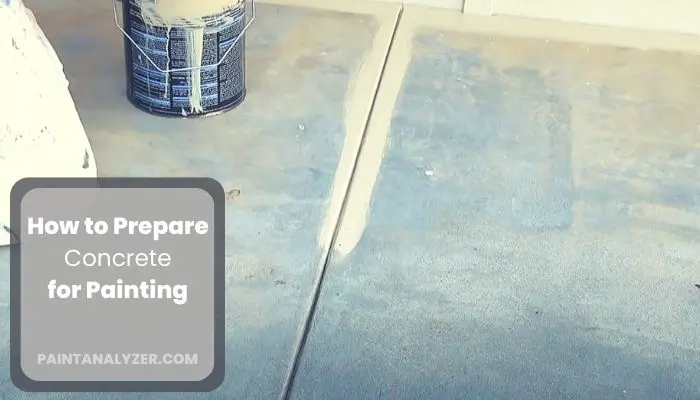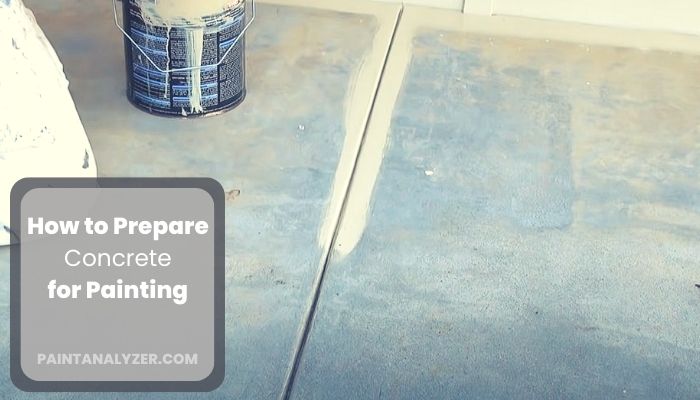Concrete is a durable material that can last for years with the proper care. However, before you can paint concrete, you need to prepare the surface properly. This will ensure that your paint job looks its best and lasts for as long as possible.
Whether you’re painting a concrete wall or floor, proper preparation is essential to ensure that your paint job looks its best. concrete is a porous material, so it’s important to seal it before painting to prevent the paint from soaking in and looking dull.

What is the best way to prepare concrete for painting?
If you’re painting a concrete surface, it’s important to properly prepare the surface beforehand. This will ensure that the paint adheres properly and lasts for a long time. Here’s how to prepare concrete for painting:
Clean the Concrete Surface
Start by cleaning the surface of the concrete. You want to remove any dirt, dust, or debris that could potentially interfere with the paint adhering to the surface. Remove any loose paint, dirt, or debris from the surface of the concrete with a wire brush or power washer. A power washer can be helpful in getting rid of tough stains or build-up. You can also use a degreaser or TSP solution.
Go through the Etching Process
Once the surface is clean, you’ll need to etch it with muriatic acid. This will create a rougher texture on the concrete which will help the paint adhere better. Be sure to wear gloves and protective eyewear when working with muriatic acid.
Let the surface dry Completely
Rinse off the acid and allow the surface to dry completely before painting. You may also want to prime the concrete before painting if you’re using light-colored paint or if you’re concerned about potential staining from the paint itself.
Repair Cracks
Patch up any cracks, holes, or other damage in the concrete with an appropriate patching compound. Allow the compound to dry completely before proceeding to the next step.
Prime the surface
Prime the concrete surface with a high-quality primer designed for use on masonry surfaces. Be sure to follow the manufacturer’s instructions carefully when applying primer to ensure best the results.
Is it necessary to prepare concrete before painting?
It is always best to prepare concrete before painting, as this will help to ensure that the paint adheres properly and lasts for a long time. If you do not prepare the concrete first, the paint may not adhere well and could peel or chip over time.
Whether you’re painting a concrete wall in your home or office, or you’re trying to spruce up an old piece of patio furniture, you’ll need to prep the concrete before painting. This means cleaning it thoroughly and applying a primer. Once the primer is dry, you can start painting.
Concrete is a porous material, which means that it can absorb paint. This can lead to uneven coloration and chipping over time. To avoid this, it’s important to clean the surface of any dirt, dust, or other debris before painting.
You can do this with a broom and dustpan, or with vacuum cleaners designed for concrete floors. Once the surface is clean, apply a layer of primer with a roller brush designed for use on rough surfaces. Allow the primer to dry completely before moving on to painting.
This will help ensure even coverage and prevent the paint from soaking into the concrete too much.

Can You Paint Straight onto Concrete without priming it?
Painting your concrete floors or walls, the best way to ensure that the paint will adhere properly and last a long time is to prime the surface first. Priming concrete is simple and only takes a few extra minutes, but it can make a big difference in the longevity of your paint job.
If you’re planning on painting your concrete floors or walls, you might be wondering if you need to prime them first. The short answer is that it’s not strictly necessary to prime concrete before painting it, but there are some benefits to doing so.
If you don’t prime your concrete before painting, the paint may not adhere as well and could start to chip or peel over time. Priming your concrete will help the paint to better adhere to the surface and should help it last longer.
Another benefit of priming concrete before painting is that it can help to hide any imperfections on the surface. If your concrete is particularly rough or has a lot of cracks, priming it before painting will help to create a smoother surface.
If you do decide to prime your concrete before painting, you’ll need to choose a primer that’s specifically designed for use on concrete. Regular paint primers won’t necessarily work as well on concrete, so it’s important to choose one that’s specifically designed for the job.
Once you’ve chosen a primer, follow the instructions on the packaging for the best results.
Prepare your Concrete surface For Painting
How to Get any Paint to Stick better to Concrete?
Whether you’re painting a concrete wall or giving your patio a fresh coat, it’s important to properly prepare the surface before you start. This will help the paint adhere better and last longer.
While you’re looking to get a paint job that will really last, you need to make sure the paint properly adheres to the concrete. Here are a few tips to get any paint to stick better to concrete:
Choose the right paint
There are special concrete paints available that are designed to adhere well to concrete surfaces. Use an exterior-grade paint that is made for concrete surfaces.
Prepare the surface
Before painting, be sure to clean the concrete surface thoroughly. You may also need to etch the surface to rough it up a bit and create a more porous surface for the paint to grip.
Apply a primer
This will help the paint to really adhere to the concrete and will create a better overall finish. Apply a primer specifically designed for concrete surfaces. This will help the paint bond better with the concrete and improve durability.
Use a paint roller with a thick nap
This will help to evenly distribute the paint and create a thicker layer, which will help the paint to last longer.
Use multiple coats
Be sure to apply at least two coats of paint, letting each coat dry completely before applying the next.
What Steps Should I Take to Prepare My Stamped Concrete Driveway and Patio for Painting?
Before painting stamped concrete driveway and patio, it’s crucial to thoroughly clean the surfaces using a pressure washer and appropriate cleaning agents. Repair any cracks or damage with a concrete patching compound, and allow ample time for the surfaces to dry completely. Finally, apply a high-quality primer before painting.
Conclusion
To sum up, freshly poured concrete is spongy, absorbent, and prone to mold and mildew. It dries quite rapidly, too. The first couple weeks after pouring, the concrete remains damp. Do not place the painter’s tape directly on top of the wet concrete. Instead, tape the wet surface and then tape the taped surface.
This will prevent the tape from sticking to the wet concrete and will avoid leaving a ridge of tape. Alternatively, use masking paper. You can use a brush to apply it, but a painter’s roller is also very effective.
Concrete must be free of dust, debris, and loose material. Use a pressure washer to scrub concrete surfaces. Rinse the surface with water and allow it to dry. Then apply your desired paint to get a nice beautiful colored concrete surface.

